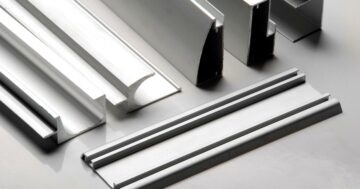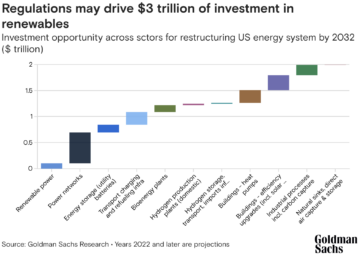
One year ago, President Joe Biden signed the Inflation Reduction Act (IRA) into law, ushering in a new era of climate policy. In that time, GreenBiz has covered the different programs and announcements spurred from the bill, ranging from ocean tech accelerator funds to interstate decarbonization efforts.
The United States has seen some undeniable wins because of the IRA, in funding, adoption and job growth. Today, exactly one year after the passage of the IRA, we’re highlighting just some examples of the law’s positive impact on the nation’s clean energy transition.
Carbon capture technology
Carbon capture utilization and storage (CCUS) and direct air capture (DAC) is an obvious beneficiary of the IRA. The law’s 45Q tax credit increases the compensation available per ton of carbon captured from $50 per ton to as high as $180.
Since last August, a barrage of CCUS and DAC projects have been announced, such as Switzerland-based Climeworks’ decision to open new facilities in the U.S., Microsoft’s plans to fund removal and the development of carbon credits, and JP Morgan Chase’s $200 million commitment to remove and store 800,000 metric tons of carbon from the atmosphere.
Most recently, the Department of Energy announced $1.2 billion to develop two commercial-scale DAC facilities in Louisiana and Texas. It’s important to note that the $1.2 billion in funds is allocated from the Bipartisan Infrastructure Law, passed in November 2021, not the IRA. Rather, the carbon captured is still eligible for the IRA’s 45Q credit.
Despite the deluge of funding going toward CCUS research and project development, there are some who believe the IRA should focus on more immediate problems. Jamie Alexander, director of Drawdown Labs, said to GreenBiz, “The Inflation Reduction Act should be focused on the immediate cutting of emissions…not necessarily on longer-term plays like carbon removal technologies that won’t really be ready until 2040 or 2050, if at all and probably not the [at] the scale we need.”
Heat pumps
Heat pump manufacturing received a boon from the IRA. The 48C Advanced Energy Project Tax Credit, which was first introduced by the American Recovery and Reinvestment Act of 2009, received a $10 million investment from the IRA. One of the main draws of 48C is the 30 percent tax credit for projects “designed to produce energy conservation technologies,” including heat pump manufacturing. Additionally, the IRA designated $500 million to the Defense Production Act to support the ramp-up of domestic heat pump manufacturing.
Powered by electricity, heat pumps are three to four times more efficient than conventional heaters and can cut up to eight times the amount of carbon dioxide emitted.
South Korea-based LG Electronics announced plans in April 2023 to open its first heat pump factory in the United States. At a roundtable event at the White House, LG North America CEO Thomas Yoon said, “Government incentives, at the federal, state and local levels, will encourage and expand domestic manufacturing.”
Energy
If it isn’t clear yet, the renewable energy sector has exploded under the IRA. According to a recent American Clean Power report, over $270 billion has been invested in clean energy projects and manufacturing facilities since the passage of the IRA, in addition to $22 billion toward manufacturing investments. As previously reported, job growth in the renewable energy sector has erupted, with over 170,000 new jobs across 44 states created, as of July 2023.
Solar funding, in particular, has seen a boost. A July report from Mercom Capital Group found that total corporate funding for the solar sector in the first half of 2023 totaled $18.5 billion, compared with the $12 billion invested in H1 of 2022. In a statement, Mercom CEO Raj Prabhu said, “Demand due to the Inflation Reduction Act is so strong that even interest rate-sensitive public market and debt financing in solar were up year-over-year.”
These advances are largely due to the different tax credits available in the legislation, such as the 45X Advanced Manufacturing Production Credit, the 48E Electricity Investment Tax Credit and the 48E(h) Increase in Energy Credit for Solar and Wind Facilities among others.
It’s complicated: Emissions reductions
A study released in July estimates that the IRA is likely to cut U.S. emissions anywhere from 29 to 48 percent by 2035 from 2005 levels. While this news is definitely a win, it doesn’t meet the Biden administration’s goal under the Paris Agreement to cut emissions by 50 percent by 2030.
The power and transportation sectors see an emissions decline of up to 75 and 32 percent by 2035, respectively. In even the most conservative of scenarios, the report finds that by 2035, zero-emitting generating sources will make up 63 percent of the grid, compared with 2022’s 41 percent.
By comparison, the agriculture and buildings sectors essentially stagnate in their gains. Neither increase in emissions, but neither decrease in any substantial way either. Alexander spoke directly to this point, saying Drawdown Labs would have liked to see “more investments [from the IRA] in food and agriculture. There was a lot [of investment] in energy, a lot of electricity, a lot of electric vehicles.”
There are other industries benefiting from the IRA – like electric vehicle production in particular – and still more waiting for their moment in the sun, like hydrogen. The IRA is still in its infancy – many programs don’t kick off until 2024 – and with it, the promise for continued growth and forward momentum. The gains felt today are just the beginning.
- SEO Powered Content & PR Distribution. Get Amplified Today.
- PlatoData.Network Vertical Generative Ai. Empower Yourself. Access Here.
- PlatoAiStream. Web3 Intelligence. Knowledge Amplified. Access Here.
- PlatoESG. Automotive / EVs, Carbon, CleanTech, Energy, Environment, Solar, Waste Management. Access Here.
- PlatoHealth. Biotech and Clinical Trials Intelligence. Access Here.
- ChartPrime. Elevate your Trading Game with ChartPrime. Access Here.
- BlockOffsets. Modernizing Environmental Offset Ownership. Access Here.
- Source: https://www.greenbiz.com/article/1-year-later-benefits-ira
- :has
- :is
- :not
- $10 million
- $UP
- 000
- 1
- 2005
- 2009
- 2021
- 2022
- 2023
- 2024
- 2030
- 2050
- 32
- 50
- 75
- a
- accelerator
- According
- across
- Act
- addition
- Additionally
- Adoption
- advanced
- advances
- After
- ago
- Agreement
- agriculture
- AIR
- Alexander
- All
- allocated
- america
- American
- among
- amount
- an
- and
- announced
- Announcements
- any
- anywhere
- April
- ARE
- AS
- At
- AUGUST
- available
- barrage
- BE
- because
- been
- Beginning
- believe
- beneficiary
- benefiting
- benefits
- biden
- Bill
- Billion
- bipartisan
- boost
- buildings
- but
- by
- CAN
- capital
- capture
- captured
- carbon
- carbon dioxide
- ceo
- clean energy
- clear
- Climate
- commitment
- compared
- comparison
- Compensation
- complicated
- CONSERVATION
- conservative
- continued
- conventional
- Corporate
- covered
- created
- credit
- Credits
- Cut
- cutting
- Debt
- Debt financing
- decarbonization
- Decline
- decrease
- Defense
- definitely
- Department
- Department of Energy
- designated
- develop
- Development
- different
- direct
- directly
- Director
- Doesn’t
- Domestic
- Dont
- draws
- due
- eight
- either
- Electric
- electric vehicle
- electric vehicles
- electricity
- Electronics
- eligible
- Emissions
- encourage
- energy
- energy conservation
- energy projects
- Era
- essentially
- estimates
- Even
- Event
- exactly
- examples
- Expand
- facilities
- factory
- Federal
- financing
- finds
- First
- Focus
- focused
- food
- Food and Agriculture
- For
- Forward
- found
- four
- from
- fund
- funding
- funds
- Gains
- generating
- goal
- going
- Grid
- Group
- Growth
- Half
- Have
- High
- highlighting
- House
- HTTPS
- hydrogen
- if
- immediate
- Impact
- important
- in
- Incentives
- Including
- Increase
- Increases
- industries
- inflation
- Infrastructure
- interest
- into
- introduced
- invested
- investment
- Investments
- IRA
- IT
- ITS
- Jamie
- Job
- Jobs
- joe
- Joe Biden
- jpg
- July
- just
- kick
- Labs
- largely
- Last
- later
- Law
- Legislation
- levels
- LG
- LG Electronics
- like
- likely
- local
- Lot
- Louisiana
- Main
- make
- manufacturing
- many
- Market
- Meet
- metric
- million
- moment
- Momentum
- more
- Morgan
- most
- Nations
- necessarily
- Need
- Neither
- New
- news
- North
- north america
- note
- November
- November 2021
- obvious
- of
- off
- on
- ONE
- open
- or
- Other
- Others
- over
- paris
- Paris Agreement
- particular
- passage
- passed
- per
- percent
- plans
- plato
- Plato Data Intelligence
- PlatoData
- plays
- Point
- policy
- positive
- power
- president
- president joe biden
- probably
- problems
- produce
- Production
- Programs
- project
- projects
- promise
- public
- Public Market
- pump
- pumps
- ranging
- rather
- ready
- really
- received
- recently
- recovery
- reduction
- released
- removal
- remove
- Renewable
- renewable energy
- report
- research
- s
- Said
- saying
- Scale
- scenarios
- sector
- Sectors
- see
- seen
- should
- signed
- since
- So
- solar
- some
- Sources
- State
- States
- Still
- storage
- store
- strong
- substantial
- such
- Sun
- support
- tax
- tax credit
- tech
- Technologies
- texas
- than
- that
- The
- their
- There.
- this
- time
- times
- to
- today
- Ton
- tons
- Total
- toward
- transition
- transportation
- two
- u.s.
- under
- United
- United States
- until
- vehicle
- Vehicles
- Waiting
- was
- Way..
- we
- were
- which
- while
- white
- White House
- WHO
- will
- win
- wind
- Wins
- with
- would
- year
- year after
- yet
- zephyrnet










